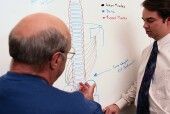Medical Education Must Adapt to Changing Times
Medical schools must adapt their admission requirements and curricula to changes in scientific theory, and are also facing a challenge to the traditional definition of who is suited to the study of medicine, according to two articles published in the July 17 issue of the New England Journal of Medicine.

THURSDAY, July 17 (HealthDay News) -- Medical schools must adapt their admission requirements and curricula to changes in scientific theory, and are also facing a challenge to the traditional definition of who is suited to the study of medicine, according to two articles published in the July 17 issue of the New England Journal of Medicine.
Jules L. Dienstag, M.D., of Harvard Medical School in Boston, writes that current college courses may not be sufficiently focused on human biology to adequately equip medical students, and that the traditional silo approach to different disciplines hinders students' ability to synthesize information. Medical curricula must also reflect new, more sophisticated concepts and new disciplines, the author adds.
Sandeep Jauhar, M.D., Ph.D., of Long Island Jewish Medical Center in New Hyde Park, N.Y., discusses the growing trend of medical students from non-traditional backgrounds, who bring with them more life experience and greater finesse in dealing with patients, but may lack the determination, focus and acceptance of hierarchy of traditional medical students.
"For now, medical school admissions committees continue to accept older, non-traditional students. Perhaps they believe that medicine needs new voices -- and given the myriad problems of health care, it is hard to disagree," Jauhar writes. "Nevertheless, I think we need more data before we can call this a viable strategy for the future."
Abstract - DienstagFull TextAbstract - JauharFull Text
Copyright © 2008 ScoutNews, LLC. All rights reserved.